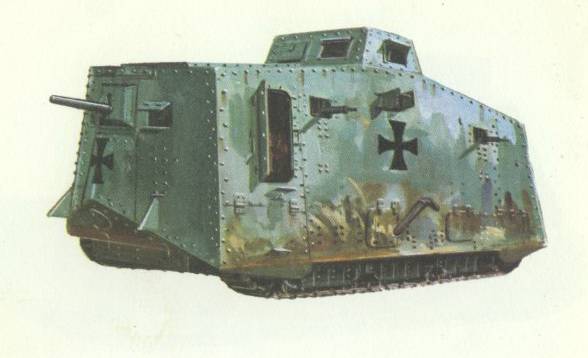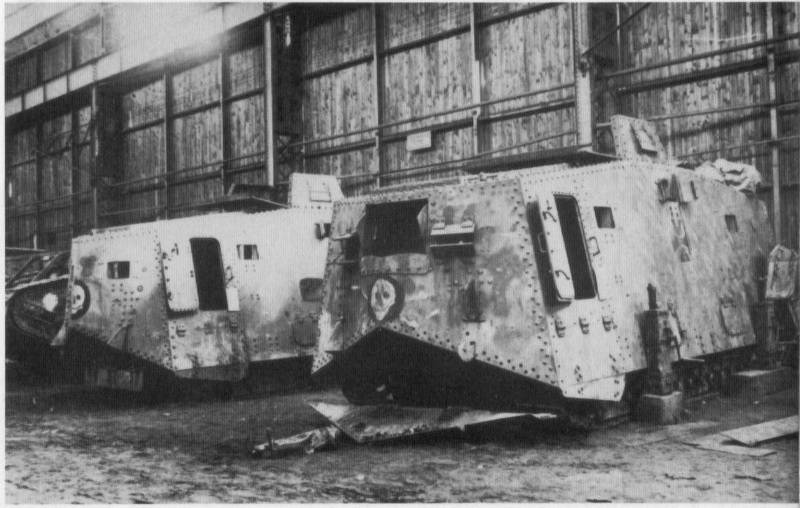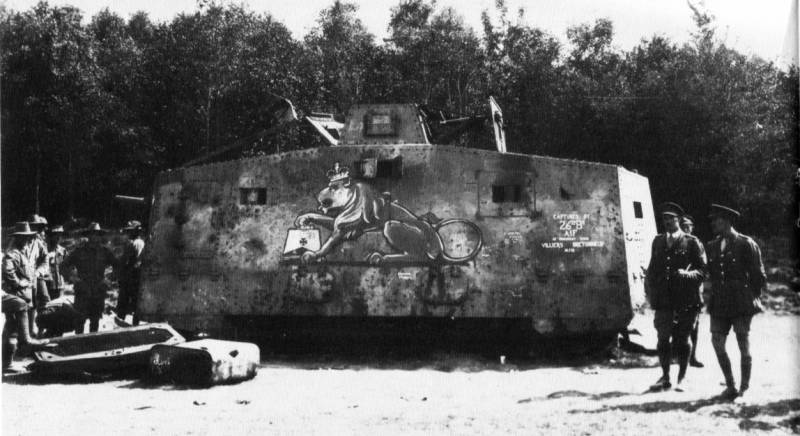Wilhelm Armor
The model for the tank was the American tractor used for agricultural work, which was already familiar to Germany in the war year, but didn’t have the tractor itself. Tracked transmission gave these machines great technical advantages - both in terms of weight, and when moving.
Interestingly, the idea of using a tracked drive (but for armored vehicles) belonged to the Germans, having appeared in December 1913. The idea belonged to a German company that offered a torpedo-shaped armored car with 2-me tracked gears. Obviously, if due attention was paid to this proposal in a timely manner, then Germany would lead in the use of tracked combat vehicles, and the German army instead of 4-year-old sitting in the trenches would have expected participation in powerful mobile hits - a blitzkrieg could be implemented on 25 earlier.
Already during the war in the summer of 1915, another German company offered machine-gun armored vehicles on tracked tracks - but since the company made great demands and the design needed to be processed, the result was also absent in this case.
September 15 The British army used tanks for the first time on 1916, and in less than a month - on October 11, the Chief of the Field General Staff suggested immediately starting work on building his tank.
The necessary financial and material support was provided, experienced designers were invited - and in a short time the drawings of the A7V tank were developed. Later it turned out that this construction was not perfect - and its shortcomings had to be eliminated. There were also economic problems. The commission to create a tank in December 1916 of the year indicated that German firms were overwhelmed with military orders, felt a strong lack of necessary materials and the first tank could be released only by the spring 1917 of the year. Coal hunger and difficulties in the transport sector played an important role.
At this time, all the attention of Germany was focused on the implementation of the program P. Hindenburg - in the first place was the manufacture aviation motors, submarines and cars. Finally, in May 1917, with significant difficulties, the first tank was ready, and the construction of the rest, due to lack of necessary materials, was delayed until the spring of 1918.
The lack of consensus on the optimal type of tracked vehicle also had a restraining effect on the development of tank production. Different requirements contradicted each other: the tank had to have strong armor, good armament, maneuverability, lightness, to represent the smallest possible target for artillery. The first two conditions were met by a heavy (large) tank, while the others were light (small) tanks. Since March, the 1917 of the year has been developed “big tank” - the first sample was to be ready in December 1917 of the year. Even by the end of the war he was not finished. The type of the so-called “small” tank was also worked out, but production could be started only from the summer of 1918, and the first thousand tanks could be ready only in November of 1919.
In fact, 20 units of domestic A7V units and fifty trophy (mostly British) tanks participated in the First World War from the German side.

Fig. 1. Tank A7V. White BT, Wood J. Tanks and other Armored Fighting Vehicles 1900 to 1918. - London, 1968.
In the matter of tactical use of tanks, due to their small size, the Germans could not follow the path of the Allies. Thus, the British tanks were combined into tank battalions (each of the 3 companies were 16 tanks in a company), and the French combined the 4 tank into a battery (4 batteries were a group). During the offensive, the tanks turned around and moved at a distance of 50 meters from each other. Overcoming artificial obstacles, they began to move to the right or left, comparing enemy trenches with the ground. For the infantry attacked the tanks.
By the fall of the 1917, the British had 3 brigades of tanks (each in the 3 battalion for 48 combat vehicles). Brigades in July 1917 were combined into a tank corps. At the same time, the French had 11 tank groups of 16 small (light) tanks and 5 groups of 16 large (infantry) tanks in each group.
In the November 1917 battles near Cambrai at the front of the 2 Army, the Germans captured the 64 British tank, of which 26 "males" (that is, with guns) and 38 "females" (with machine guns). Trophy tanks were sent to Charleroi, where they organized a tank park. Repair of these machines was very slow - not enough materials and labor. But the main difficulty was associated with the manufacture of engines - all power was used to build aircraft engines and engines for artillery tractors.
In the winter of 1917 / 18, the first A7V tanks, which took part in the spring offensive in France, entered service.
Due to the small size of their tank fleet, the Germans were forced to form tank sections. This also influenced tactics - it was impossible to use tanks massively, and the squads were attached to combined-arms formations and units. So, when in January 1918 of the year the 1 tank department was formed (5 tanks of type А7V), it was attached to the assault battalion.
In the first battle of the German tanks, 21 March 1918, at St. Kantin, took part 1-e (4 tank A7V) and 2-e (5 trophy tanks) tank divisions. Of these 9-ti in the 2-x engines have failed, even 2 suffered greatly from the allied artillery fire.

Fig. 2. The A7V tanks No. 501 and 506 are participants of the March 21 battle during the repairs in Charleroi. Photo: Deutsche Kampfwagen Im 1. Weltkrieg, - Dorheim, 1988.
In early April, these units were ready for new battles - and they were joined by the newly formed tank units. The April 9 offensive on the front of the 6 Army 11 and 12 Armored Divisions (formed from captured vehicles) did not produce a result - the tanks could not move on the heavily sodden soil.
The April 24 offensive was accompanied by brilliant success. The 1, 2 and 3 tank squads took part in the battle. Kashi had a tank battle - and the German tank 1 fought off the enemy’s 7 tanks and destroyed 3 of them. 2 German tanks remained on the battlefield, and fell into the hands of the enemy.
Fig. 3. Tank А7V No. 506 "Mephistopheles" (German tanks had proper names) - the British trophy (the English emblems applied to the car). 25 April 1918. Photo: Deutsche Kampfwagen Im 1. Weltkrieg, - Dorheim, 1988.
During May, 13 and 14 tank squads were formed from captured tanks, and on May 28, together with the 11 and 12 squadrons, took part in the 7 army battle southeast of Reims The 11 and 12 units returned from combat with only two combat-ready tanks.
31 May and 1 June 1, 2, 3, 11, 12, 13 and 14 units took part in the 1 army on Reims. In these battles, tank squads formed from captured tanks were heavily damaged by enemy artillery fire.
June 8 The 1 and 3 units took part in the 18 Army's attack on Orville-Merv.
July 15 The 11, 12, 13 and 14 units took part in the Champagne battles of Saint Suplet-Saint Hiller. In these battles, 4 tanks were burned, 4 exploded on mines, and 1 was stuck in artificial obstacles in the front line of the enemy’s defenses.
In the July battles, the 1 and 2 divisions distinguished themselves in the 22 and 123 infantry divisions on La Nyuville and Paradis.
In August, the Germans formed 15 and 16 units from captured tanks.
31 August The 2 Division supported the 16 Bavarian Infantry Division offensive at Fremikur, and the 11 Division, 15 Division and 16 Division fought south of Cambrai.
October 11 The 1 and 3 units took part in a defensive engagement west of Ivi. Moreover, the combat merits of these units were noted by the command, which reported that the tanks had a great help during a desperate but unsuccessful attempt by the enemy to break through on the 12-kilometer front of the German defense.
The last battle in early November was carried out by the 12, 13 and 14 units - at the front of the 17 army they supported a counterattack of the 28 reserve division from Seburg.
Even a few tank units brought many benefits to the Germans. But they were too weak to influence the outcome of the war. The tank proved to be an excellent tactical tool, but the operational influence of the German tank units (again, due to their small size) was not felt.
The very typology of tanks (heavy vehicles of domestic and British production) turned the first German tank units, first of all, into a tactical tool for supporting infantry on the battlefield.
A huge role was played by the fact that Germany’s military and political leadership underestimated the value of the tank, as well as miscalculations related to the delay in the production of combat tracked vehicles. The workload of German production with other orders also had a great influence - for the rapid restructuring of enterprises it was necessary not only to have raw materials, but also to free part of the automobile factories from naval, aviation and artillery orders. In addition, spare parts, vehicles and other property, as well as trained crews were required for tank units.
Only mass (unlikely in the conditions prevailing at the end of the war) production of tanks could have an operational and strategic impact on the course and outcome of the war. Having underestimated the new weapon in the most favorable period for its production, the German military leadership deprived itself of a powerful and promising weapon.

Information